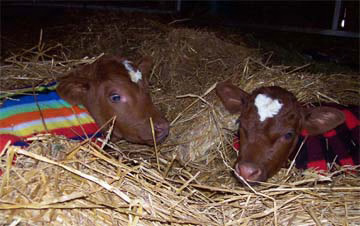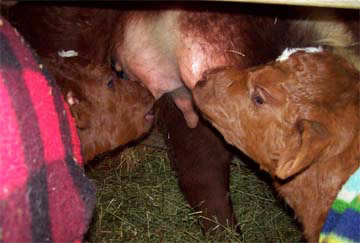We Live in a Marginal Zone
By: Lana Kaiser Date: 05/4/2012 Category: | Animal Agriculture |
We live in a marginal zone - this means that when I finally get the interactive weather on the computer, that weather has already passed us by, so I periodically check with the morning programs to get the local weather. And what do I see on national news? TV celebrities standing on the plaza complaining about the cold and snow, wearing 4 inch heels with open toes (not the men), short coats, no gloves, no hats, no scarves, but an umbrella - to protect them from the snow. Now I grew up in Buffalo, NY and we know snow, and we know, as do most farmers and ranchers, that an umbrella does not protect against snow, and furthermore an umbrella is not on the farmers list of favorite tools costing less than 100 dollars. Bad weather in a concrete city surrounded by tall buildings is nothing compared to bad weather on the farm or ranch. I suspect that if these TV personalities walked from my drive to my barn they would require some time in the calf warmer.
 Ugly sweater contest: calf edition! Ugly sweater contest: calf edition! |
If you are a control freak, you probably don't want to be a farmer and chances are you don't have temperament for being a farmer. I used to be a control freak, I now realize that I only have the illusion of control, and I have learned to accept that illusion as reality. You can plan and organize and revamp and build and haul, you can study and learn and try harder - but ultimately Mother Nature is in control and most times she has the last laugh.
Everything is much tougher in winter. Tractors, skid steers and even trucks have to be plugged in or they won't start. If the machinery won't start you can't plow and you spend all day carrying hay thru the snow - it is pretty exhausting. Things freeze - the frost free hydrant (basically a faucet outside), the valve on the automatic waterer, the hose, the water tank - you discover the most valuable tools costing less than 100 dollars are a hair dryer and a sledge hammer - what you can't melt you can pound. In cold weather cows need more feed for maintenance (i.e. basal requirements) so there is more manure - and it freezes, some just as it landed - bizarre semi artistic piles perfect to trip a human checking cows by flashlight. Everything is harder in winter.
The best winter in Michigan is when it snows a couple of feet in December, the ground freezes, and it doesn't thaw until March or April. But that rarely happens in Michigan - we get snow in November and then 6 inches of rain, some sleet, more snow, more rain and warm weather in January - what does that give us? Mud - I truly detest mud, more so I think than my cows.
Cows don't mind cold. Cattle (and all ruminants) have 4 chamber stomachs - the abomasum (like our real stomach), the omasum, the reticulum, and the rumen. The rumen is a 50 gallon fermentation vat, and as such makes heat - so if a cow can get food and water - cold is not a big issue. Cows will eat snow, will lie in snow and on a sunny day will lounge in snow. Cows will play in snow and rub their heads in snow piles. Cows don't like wind, and you can see them all lined up with their backs against the wind, and if they have calves the calves will all be lined up in front of the cows and out of the wind. Cows really don't like horizontal pelting sleet or rain and as soon as it starts you can watch them run for cover.
 Calves need more food in cold weather, too Calves need more food in cold weather, too |
When a barn is comfortable for people it is likely not a good environment for cows. Fresh air is important for the health of cows and calves - poor air quality exacerbates respiratory problems in calves. My barn basically has no walls - the beauty of that is that air quality is always excellent and my calves do not get pneumonia. The down side is that Mother Nature can give us a swirling high wind snowstorm and I can have a barn full of snow. To protect my calves from the wind I use a variety of panels and tarps on the big wind side (south west wind whips across the pasture and fields) so that everything below calf height is wind free. And over time I have modified how I prepare for winter, putting some larger tarps on the wind ward side - but you know sometimes the snow and wind comes from the north east and the barn fills with snow.
Now snow per se is not a problem - but when Mother Nature decides she wants a warmer temperature, that snow melts and the deep straw bedding gets wet. Cows covered with snow come in to rest, and if that snow melts off the cows and the straw gets wet. Add to that the fact that cows do provide about 50 pounds of fertilizer per day which doesn't freeze in warm winter weather and the straw gets wetter. When things are not frozen in the winter we haul and add straw every day to keep the pens and the barns dry and our cows and calves clean.
 You haven't seen the hair dryer, have you? You haven't seen the hair dryer, have you? |
In the spring we mobilize against the inevitable mud. Last summer we mobilized early for 2012 - we excavated around the barn yard and hauled over 500 tons of slag to make a firm dry area around the barn. This was one win for the farmer over Mother Nature.
This winter was really mild - in fact one day in March the thermometer on the barn roof said 99 degrees - yes we had heat and flies and mosquitoes in March - it didn't seem right to take down tarps in March but the hairy big cows were hot and hadn't shed yet - so March or not the tarps and the panels came down. The daffodils came out, the fruit trees blossomed, the grass grew green and began to inch upward. And we worried - was it really spring? Was it going to snow? We left the hair drier in the barn. You never know when you will have to unthaw a hydrant.
About The Author
All Authors Of This Article: | Lana Kaiser |











